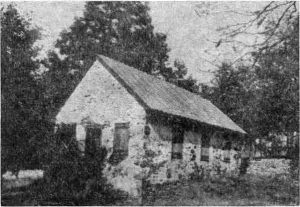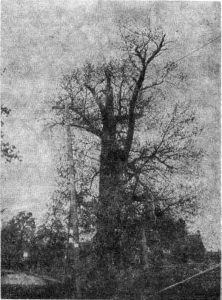 The first picture shown in today’s column has been taken from an interesting collection of old photographs in the possession of F.G. Farrell, of Upper Gulph road, Strafford.
The first picture shown in today’s column has been taken from an interesting collection of old photographs in the possession of F.G. Farrell, of Upper Gulph road, Strafford.
It shows the little old Eagle School as it looked in the 1800’s, before it was restored to its present-day condition in 1897. This restoration was done by a Board of Trustees acting for an interested group determined on the preservatlon of one of the most historic landmarks in this section.
The fund raised for this purpose was made up for the most part from a large number of small contributions, as related by Henry Pleasants in his book “Old Eagle School, Tredyffrin, 1767-1909.”
Mr. Pleasants writes: “The interest of practically the whole community in the old place was substantially manifested in the many contributions offered to aid the work of restoration. None of these individual contributions exceeded $25. Up to this amount they varied from the unique contribution from 20 boys of the Malvern Grammar School, who at the instance of their teacher, Miss Hannah Epright, of Berwyn, contributed five cents each… the average amount of all contributions was $6.71. But the spirit behind the contribution, manifested in many ways, was perhaps the most inspiring feature in the unusual enterprise”. A picture of this restored building, as shown in contrast to today’s picture, will illustrate next week’s column.
When it was established, Eagle School was placed under the control and management of trustees, or “committeemen” as they were sometimes known. These men held a position similar to that of our present day school directors. The last formal election of these trustees is said to have taken place in the old building about 1835, at a meeting held “for the purpose of securing better educational facilities for the neighborhood.”
Many of the names of these trustees have been preserved, not in record form, but in the memories of those who have passed their names down from generation to generation. Among those from this neighborhood were William Siter, John Pugh, Nathaniel Jones, Samuel Cleaver, Robert Kennedy, landlord of “The Unicorn”, and Edward Siter, landlord of “The Spread Eagle”.
Among other rural schoolhouses of an early date that have been preserved to the present generation are the Camp School, at Valley Forge, restored by the Valley Forge Park Commission; Diamond Rock School, near Howellville, and the Octagon School House near Newtown Square.
From the time that the first small crude building, known as the Eagle School, was built, it was not only school and church, but also a social center of the rural life of the neighborhood. It was a public meeting place when militia companies were organized and drilled and when political meetings were held. On the lighter side of life it was the meeting place for singing groups and debating clubs.
A quaint invitation, still in existence, to a debate to be held at the school in March, 1822, is early evidence that the Eagle School was among the pioneers in the “lyceum movement” which was to become an integral part of the life of the early settlers in this section.
Records show that, as early as 1835, the Chester County Education Convention organized a County Lyceum, with a full roster of officers. And only a few years later the Radnor Lyceum was organized, with Hugh Jones Brooke, as president. Perhaps the most outstanding of these Lyceum meetings to be held in Old Eagle School was one already described at length in this column, the free exhibition of the telegraph in 1832.
 The second picture illustrating this week’s column has been taken from Mr. Pleasants’ book. It is that of the “Sentinel”, the chestnut tree that was taken down when the Strafford drug store was built at the corner of Old Eagle School road and Lancaster pike. During the encampment of the American army at Valley Forge, the Spread Eagle Inn was used as an outpost, and this great tree, over six feet in diameter and some 75 feet tall, was utilized as a signal station for that picket.
The second picture illustrating this week’s column has been taken from Mr. Pleasants’ book. It is that of the “Sentinel”, the chestnut tree that was taken down when the Strafford drug store was built at the corner of Old Eagle School road and Lancaster pike. During the encampment of the American army at Valley Forge, the Spread Eagle Inn was used as an outpost, and this great tree, over six feet in diameter and some 75 feet tall, was utilized as a signal station for that picket.
The next signal tree was just at the top of the hill north of the Doyle Nurseries. Other trees stood at intervals all the way from the one near the old schoolhouse to Valley Forge itself.
L. E. Davis, of Weadley road, Strafford, still remembers the stories his grandfather told him of these old trees. When the big chestnut shown in today’s picture was taken down to make room for the drug store, it was rescued from burning by a Mr. Barr, of Phoenixville, who still has much of it stored in his barn. Mr. Davis himself has a piece of the old tree. And from parts of it Mr. Barr made bootjacks which were sent to the museums of a number of large American colleges.
(To be Continued)
